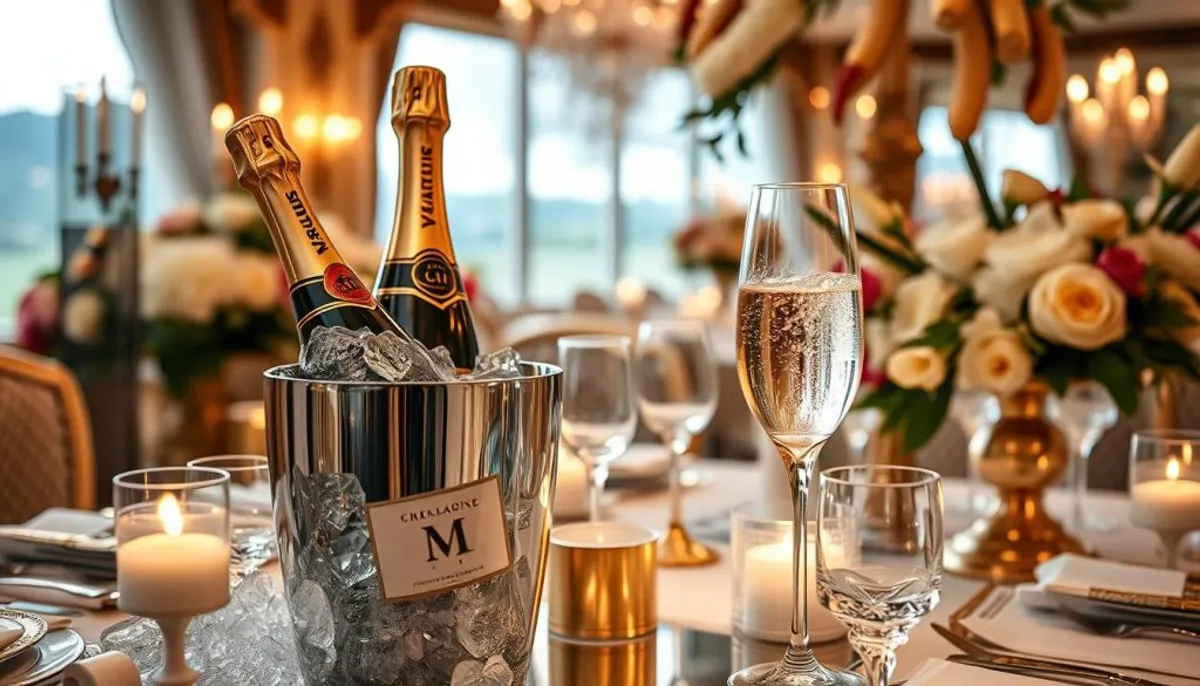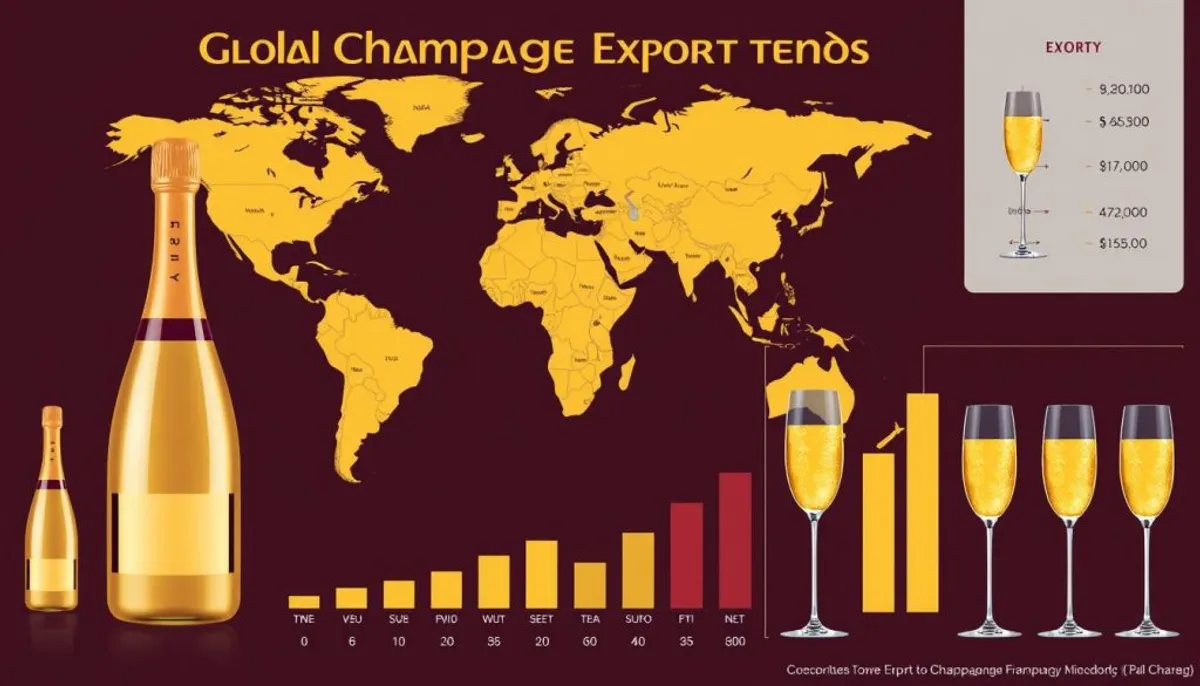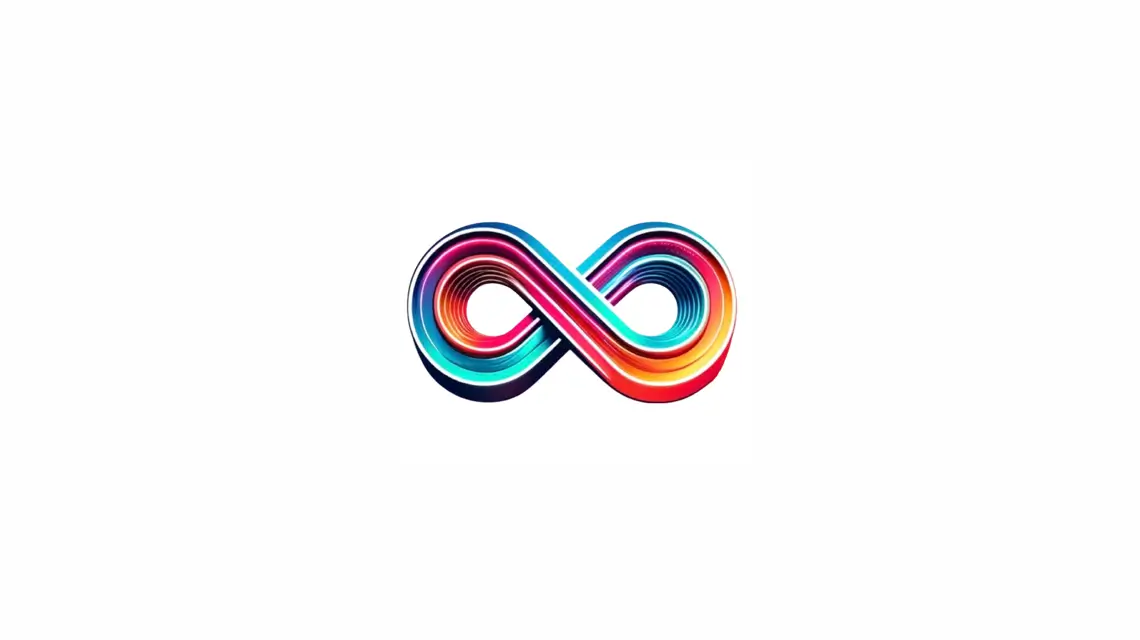Champagne M epitomizes the pinnacle of excellence in the realm of premium French champagne. It is meticulously crafted within the Champagne region, embodying the rich heritage of winemaking traditions. Each bottle narrates a tale of unwavering dedication, mastery, and the distinctive terroir that distinguishes Champagne.

The Champagne region’s unique terroir, characterized by chalky soils and a cool climate, serves as the ideal environment for producing exceptional bubbles. Champagne M leverages these natural elements, combining Chardonnay, Pinot Noir, and Pinot Meunier grapes to create a wine that is both intricate and invigorating.
Enthusiasts globally seek out Champagne M for its crisp flavors and refined effervescence. It is no surprise that more than half of all Champagne production is exported, with the United States, United Kingdom, and Japan at the forefront in their appreciation for this French gem.
Key Takeaways
- Champagne M exemplifies premium French champagne craftsmanship
- The Champagne region’s unique terroir contributes to the wine’s quality
- Three main grape varieties are used: Chardonnay, Pinot Noir, and Pinot Meunier
- Over 50% of Champagne is exported globally
- Top export markets include the USA, UK, and Japan
- Champagne M represents luxury and celebration in the wine world
The Essence of French Champagne Heritage
The Champagne history is a centuries-long tale, set against the backdrop of France’s picturesque Champagne region. Its origins trace back to the 17th century, where it found favor in royal courts. Over time, it evolved into a quintessential symbol of luxury.
Origins in the Champagne Region
By the late 19th century, Champagne’s vineyards sprawled over 60,000 hectares. The region faced a devastating crisis in 1863 when phylloxera ravaged the vines. In response, winegrowers came together, forming the Champagne Winegrowers’ Association in 1898. Their mission was to replant with resistant vines.
Traditional Production Methods
The méthode champenoise, recognized as UNESCO Intangible Cultural Heritage in 2015, encapsulates Champagne’s production essence. This method mandates a minimum 15-month aging period. For vintage varieties, the requirement escalates to at least 36 months. The remuage stage, where bottles are gradually tilted and turned, can span 4-6 weeks when done manually.
Protected Designation of Origin
AOC regulations are the guardians of Champagne’s authenticity. These stringent rules dictate that only grapes grown in the Champagne region can be used. In the 1980s, producers embraced environmentally friendly practices. By 2003, this led to a 15% reduction in the carbon footprint of Champagne winegrowing.
Understanding Premium Champagne Classifications
Champagne categories unveil the intricate world of French sparkling wine. They span from the dry Brut Nature to the luscious Doux, appealing to various tastes. This system aids in understanding the vast Champagne landscape.
Vintage Champagne is a distinct category. It is made from grapes of a single, outstanding harvest year, highlighting that season’s unique traits. In contrast, non-vintage Champagnes blend grapes from different years to achieve a consistent taste.
At the top of Champagne’s hierarchy are the prestige cuvée. These are the finest selections from renowned houses, known for their high quality and meticulous craftsmanship. They often come with a higher price tag due to their exceptional nature.
The Champagne region’s classification system has undergone significant changes. Introduced in 1919, the échelle des crus ranked villages by grape quality. It identified 17 grand cru and 42 premier cru villages, laying the groundwork for today’s premium market.
| Classification | Description | Examples |
|---|---|---|
| Non-Vintage | Blend from multiple years | Moët & Chandon Imperial |
| Vintage | Single exceptional year | Dom Pérignon |
| Prestige Cuvée | Top-tier offering | Louis Roederer Cristal |
The official échelle des crus system was discontinued in 2004. Yet, the terms “grand cru” and “premier cru” remain significant in Champagne marketing. Today, they symbolize historical quality rather than a formal ranking.
Champagne M: A Symbol of Luxury and Excellence
Champagne M epitomizes luxury and excellence in the realm of premium sparkling wines. This esteemed brand has distinguished itself in the world of fine wines, delivering an unmatched tasting experience to connoisseurs.
Distinctive Characteristics
The Champagne M quality is evident in its unique attributes. The wine boasts fine, persistent bubbles that dance in the glass, a hallmark of superior craftsmanship. Its golden hue hints at the richness within, inviting enthusiasts to savor every sip.
Tasting Notes and Profile
Luxury Champagne flavors come to life in Champagne M. The palate is greeted with a symphony of tastes, from crisp apple and citrus notes to deeper tones of brioche and toasted almonds. This complexity is a testament to the brand’s commitment to excellence.

Production Standards
The creation of this premium sparkling wine adheres to strict guidelines. Champagne M follows the méthode champenoise, a rigorous and labor-intensive process that ensures top-tier quality. Each bottle undergoes meticulous checks to meet the highest criteria of luxury Champagne.
| Characteristic | Description |
|---|---|
| Bubbles | Fine and persistent |
| Color | Golden hue |
| Aroma | Complex bouquet of fruit and toast |
| Taste | Balanced blend of crispness and depth |
| Aging | Continues to evolve, improving over time |
Popular Champagne Houses and Their Signatures
The realm of luxury Champagne is graced by iconic houses that have epitomized excellence for centuries. These premier brands have forged unique identities and signature styles, distinguishing them in the competitive sparkling wine market.
Moet & Chandon Legacy
Founded in 1743, Moet & Chandon is the largest Champagne house. It boasts tens of millions of bottles sold annually, solidifying its status as a cornerstone in the luxury Champagne sector. Their Imperial Brut, priced between $60 to $80, embodies accessible luxury. The blend typically includes 30-40% Pinot Meunier, contributing to its distinctive taste profile.
Veuve Clicquot Excellence
Veuve Clicquot, established in 1772, is celebrated for its Yellow Label Brut. The house’s prestige cuvée, La Grande Dame, has garnered quality scores ranging from 88 to 96, showcasing consistency in excellence. Veuve Clicquot’s approach balances tradition with innovation, cementing its place among top Champagne brands.
Taittinger Traditions
Taittinger, with roots dating to 1734, is renowned for its Brut Reserve. The house exemplifies the artistry of Champagne production, focusing on Chardonnay-dominant blends. Taittinger’s commitment to quality is evident in their extended aging process, which contributes to the complexity of their wines.
| Champagne House | Founding Year | Signature Cuvée | Average Price (US) |
|---|---|---|---|
| Moet & Chandon | 1743 | Imperial Brut | $60-$80 |
| Veuve Clicquot | 1772 | Yellow Label Brut | $55-$75 |
| Taittinger | 1734 | Brut Reserve | $50-$70 |
These iconic Champagne houses continue to shape the industry, balancing tradition with innovation to meet the evolving tastes of Champagne enthusiasts worldwide.
Price Points and Value Proposition
Champagne prices span a broad spectrum, reflecting the esteemed quality and prestige of these premium sparkling wines. Brands such as Veuve Clicquot and Moët & Chandon command premium prices due to their storied reputation and rigorous production standards. For instance, Veuve Clicquot’s Yellow Label, a favorite among American consumers, is priced around $60 per bottle, with annual sales in the US reaching 400,000 cases.
The luxury wine investment market views Champagne as a highly valuable asset. High-end cuvées can command hundreds of dollars per bottle, with vintage and limited edition releases reaching even more exorbitant price points. This elevated cost is a reflection of the intricate production process, the necessity for extended aging, and the brand’s prestige.
| Champagne Brand | Price Range | Production Notes |
|---|---|---|
| André Clouet Brut Grand Reserve | $33+ | Affordable luxury option |
| Gosset Brut Excellence | $48+ | 30,000 cases/year, unique blend |
| Pol Roger Reserve NV | $50+ | 4 years lees aging |
| Krug | $200+ | Single-vineyard, single-year vintages |
The allure of Champagne lies in its unparalleled quality, rich heritage, and celebratory essence. While Prosecco presents a more budget-friendly sparkling alternative, Champagne’s intricate production techniques and stringent regional standards contribute to its elevated pricing and luxury status in the global wine market.
Food Pairing Guide for Luxury Champagnes
Champagne food pairings elevate dining experiences to new heights. From classic combinations to modern gastronomy, luxury wine and food create unforgettable moments. Let’s explore gourmet Champagne combinations that will tantalize your taste buds.
Classic Pairings
Brut Champagne, accounting for 73.9% of U.S. shipments in 2017, pairs perfectly with oysters and caviar. The crisp acidity cuts through rich flavors, creating a harmonious balance. For cheese lovers, try pairing a Blanc de Blancs with creamy Brie or tangy Roquefort.
Modern Gastronomy Matches
Innovative chefs are pushing boundaries with Champagne food pairings. Rosé Champagne, often a blend of Chardonnay and Pinot Noir, complements sushi and sashimi beautifully. The wine’s strawberry notes enhance the delicate fish flavors. For a surprising twist, pair a Blanc de Noirs with spicy curry dishes – its full-bodied nature stands up to bold spices.
Celebration Menus
Luxury wine and food shine in celebration menus. Start with Perrier-Jouët Belle Epoque Blanc de Blancs ($361) alongside fresh oysters. Follow with grilled salmon paired with Taittinger Comtes de Champagne Blanc de Blancs ($200). End your feast with a Doux Champagne and chocolate truffles for a decadent finale to your gourmet Champagne combinations.
| Champagne Style | Food Pairing |
|---|---|
| Brut | Oysters, Caviar, Fish and Chips |
| Rosé | Sushi, Grilled Salmon, Dark Chocolate |
| Blanc de Blancs | Seafood, Chicken, Soft Cheeses |
| Blanc de Noirs | Steak, Lamb, Spicy Curries |
Storage and Serving Recommendations
Proper Champagne storage is essential for preserving its quality and flavor. Store bottles horizontally in a cool, dark environment with a consistent temperature between 45°F and 65°F. It is also important to maintain humidity levels between 70-85% to prevent cork drying. Non-vintage Champagnes can be stored unopened for 3-4 years, while vintage cuvées can age for 5-10 years.
When it’s time to enjoy your Champagne, the serving temperature is crucial. Chill your bottle to 8°C-10°C for the best taste. Be cautious when opening, as Champagne corks can pop out at 50 mph due to the high pressure inside the bottle!
Choosing the right Champagne glassware is key to enhancing your drinking experience. Use tall, narrow flutes to preserve bubbles and concentrate aromas. For vintage or complex Champagnes, wider tulip glasses allow full flavor development. Always rinse glasses with hot water before use, avoiding cloth drying to prevent dulling the effervescence.
| Storage | Serving |
|---|---|
| 45°F – 65°F | 46°F – 50°F |
| 70-85% humidity | Flutes or tulip glasses |
| Horizontal position | Open carefully |
Remember, an opened bottle can stay fresh for 3-5 days if properly sealed. For long-term aging, consider magnum bottles. They offer a slower, steadier aging process due to their lower ullage ratio.
Comparing Premium Sparkling Alternatives
In the realm of sparkling wine, Champagne alternatives present a plethora of premium options. These alternatives to Champagne offer a range of choices that rival its luxury. Let’s dive into some popular alternatives that challenge Champagne’s status as the pinnacle of sparkling wines.
Prosecco vs Champagne
Prosecco, a beloved sparkling wine from Italy, differs from Champagne in several key aspects. It is crafted from Glera grapes, resulting in a lighter, fruitier taste with larger bubbles. This makes Prosecco more accessible, with prices under $15, ideal for casual celebrations.
Cava Distinctions
Spain’s Cava, while sharing similarities with Champagne in its production methods, employs different grape varieties. Cava is generally drier than Prosecco and closer to Champagne in its flavor profile. With prices around $10, it offers a budget-friendly alternative for those seeking Champagne-like qualities.
Crémant Options
Crémant, produced in various French regions outside Champagne, presents high-quality bubbles at a more accessible price point. These wines offer a variety of styles similar to Champagne, making them an excellent choice for exploring French sparkling wines beyond Champagne.
| Sparkling Wine | Origin | Main Grapes | Price Range | Flavor Profile |
|---|---|---|---|---|
| Champagne | France | Chardonnay, Pinot Noir, Pinot Meunier | $30+ | Complex, yeasty, crisp |
| Prosecco | Italy | Glera | $10-$15 | Light, fruity, larger bubbles |
| Cava | Spain | Macabeo, Parellada, Xarel·lo | $10-$20 | Dry, crisp, earthy |
| Crémant | France (various regions) | Varies by region | $15-$25 | Diverse, Champagne-like |
These alternatives to Champagne offer excellent value, often priced at a quarter to half of decent Champagne. For those eager to explore beyond traditional Champagne, these options provide a diverse range of flavors and styles. This allows wine enthusiasts to expand their palates without straining their budgets.
Global Export and Availability
Champagne export trends indicate a vibrant market for luxury sparkling wine. International sales patterns show shifts in consumer tastes and economic conditions. Despite recent hurdles, the global demand for this esteemed French drink persists.
International Markets
The Champagne export landscape is undergoing transformation. In 2024, total shipments are forecasted to fall to 271 million bottles, a 9.4% decline from 2023. Notably, Japan, Italy, and Hong Kong experienced substantial decreases in 2023. Yet, the US, UK, and Singapore remain at the forefront in terms of Champagne imports by value.
Shipping Considerations
Proper shipping is essential when purchasing luxury sparkling wine. Maintaining the right temperature and handling with care are vital to preserve Champagne’s quality during transport. Many premium houses provide specialized shipping to guarantee their products arrive at international destinations in pristine condition.
Purchase Guidelines
For those contemplating the purchase of Champagne, consider these guidelines:
- Opt for authorized retailers or direct imports for authenticity
- Verify the use of proper storage and shipping methods
- Stay informed about market trends that could influence availability and pricing
| Year | Total Export Value | Notable Market |
|---|---|---|
| 2022 | €4.2 billion | UK (12% growth) |
| 2020 | €2.5 billion | Global decline |
| 2015 | €2.2 billion | Start of growth trend |

Despite the ebbs and flows, Champagne continues to embody luxury and celebration globally. The industry’s ability to adapt to market shifts ensures that aficionados can still savor this exquisite sparkling wine worldwide.
Conclusion
The luxury Champagne experience is a journey through the pinnacle of French wine excellence. Originating from the historic Champagne region, just 160 km from Paris, it is a beverage steeped in tradition and prestige. Only sparkling wines from this area can bear the Champagne name, distinguishing it from other premium sparkling wine indulgences like prosecco or cava.
Champagne’s unique character is rooted in its strict production methods and grape varieties. Chardonnay, pinot noir, and pinot meunier grapes contribute to the distinct flavors that wine lovers cherish. The méthode traditionelle ensures each bottle delivers the quality expected of this world-class drink.
Beyond its taste, Champagne embodies celebration and luxury. Whether enjoyed in the grand houses of Reims and Épernay or savored at home, it offers more than just bubbles. With potential health benefits and a rich cultural significance, Champagne continues to captivate wine enthusiasts globally, proving why it remains the king of sparkling wines.
RelatedRelated articles



